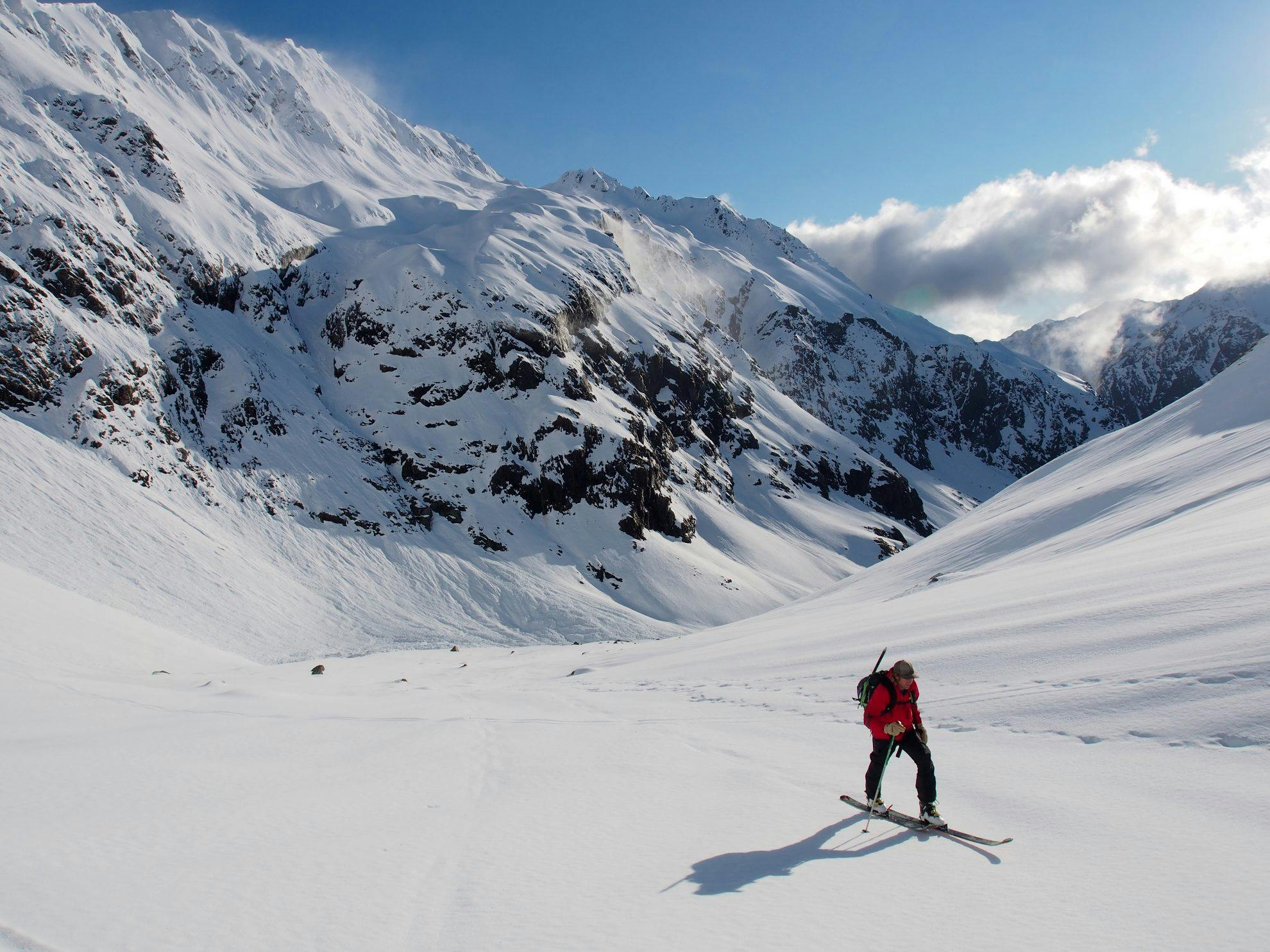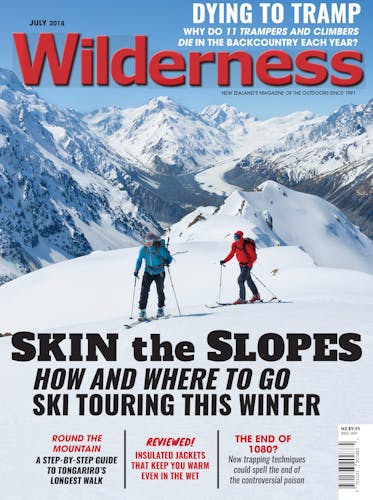Ski touring is a wonderful way to enjoy the backcountry in the winter, and one of the best ways of getting fit for it is tramping.
At first glance, a ski tourer might look like a normal resort skier, but if you look closer you will notice a few differences. The main one being they can ski both up and downhill.
This ability to defy gravity and travel up slopes is called ‘skinning’ and is achieved by using touring bindings that allow the heel to lift so the ski can be pushed forward. Removable sticky skins attached to the ski provide grip. Once the skier gets to the top, the skins are removed, the heels are locked in place, and gravity does its thrilling work.
Like tramping, ski touring is about the freedom to go where you like under your own steam. With large sections of New Zealand’s high country covered in snow from July to October, touring allows backcountry users to explore areas they would otherwise struggle to visit on foot during this time of year.
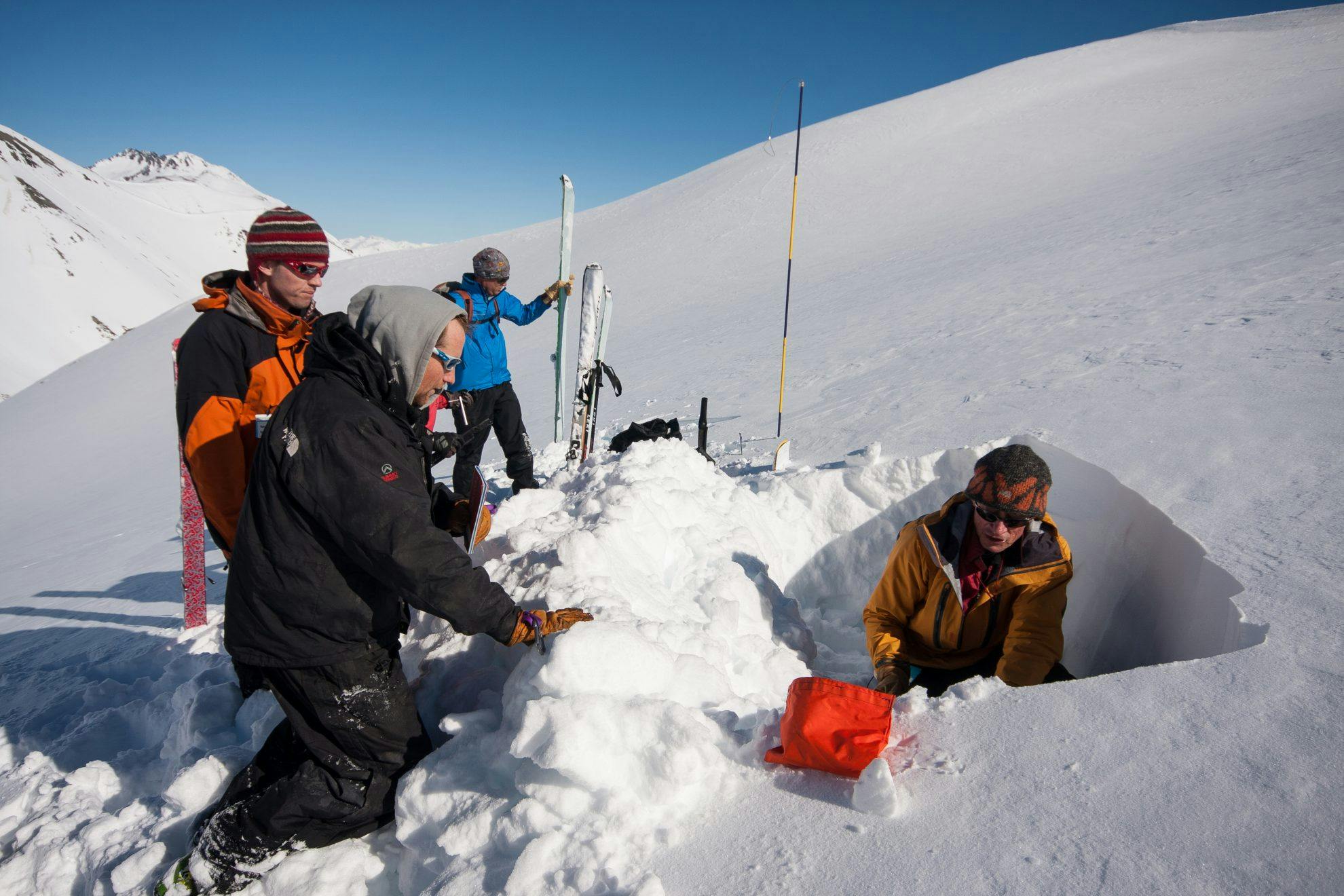
Skills
If you want to get into ski touring and haven’t done much skiing before, you’ll need to master a few skills.
Learn to ski: You don’t need to be a double black diamond extreme skier to enjoy touring, but you should be able to ski intermediate runs at a ski field. While it’s possible to learn on the go, this tends to be a slow and uncomfortable way to master the basics. It’s also potentially dangerous if you find yourself in terrain outside of your ability. At the very least, master your downhill turns on a groomed slope before you head into the backcountry.
Know your ice: It’s not uncommon to encounter ice, powder and slush on the same day, so it’s important to have the skills to handle whatever the mountain throws at you. Knowing how to use an ice axe and crampons and move over icy terrain are all useful skills to have.
Avalanche awareness: Before heading into the backcountry, you’ll need to know how to travel safely in, or identify and avoid, avalanche terrain. Climbing clubs, ski fields and guiding companies all run courses that will give you the basics of snowpack formation and show you how to recognise and avoid avalanche-prone terrain. You’ll also learn how to search for someone buried by an avalanche. These courses also provide a means to meet other people interested in ski touring.
Get fit: Strong legs and good cardio fitness are keys to making the most of the day. The best way to prepare for the touring season is to go tramping: a few early winter hikes will get your legs in shape for when the snow arrives.
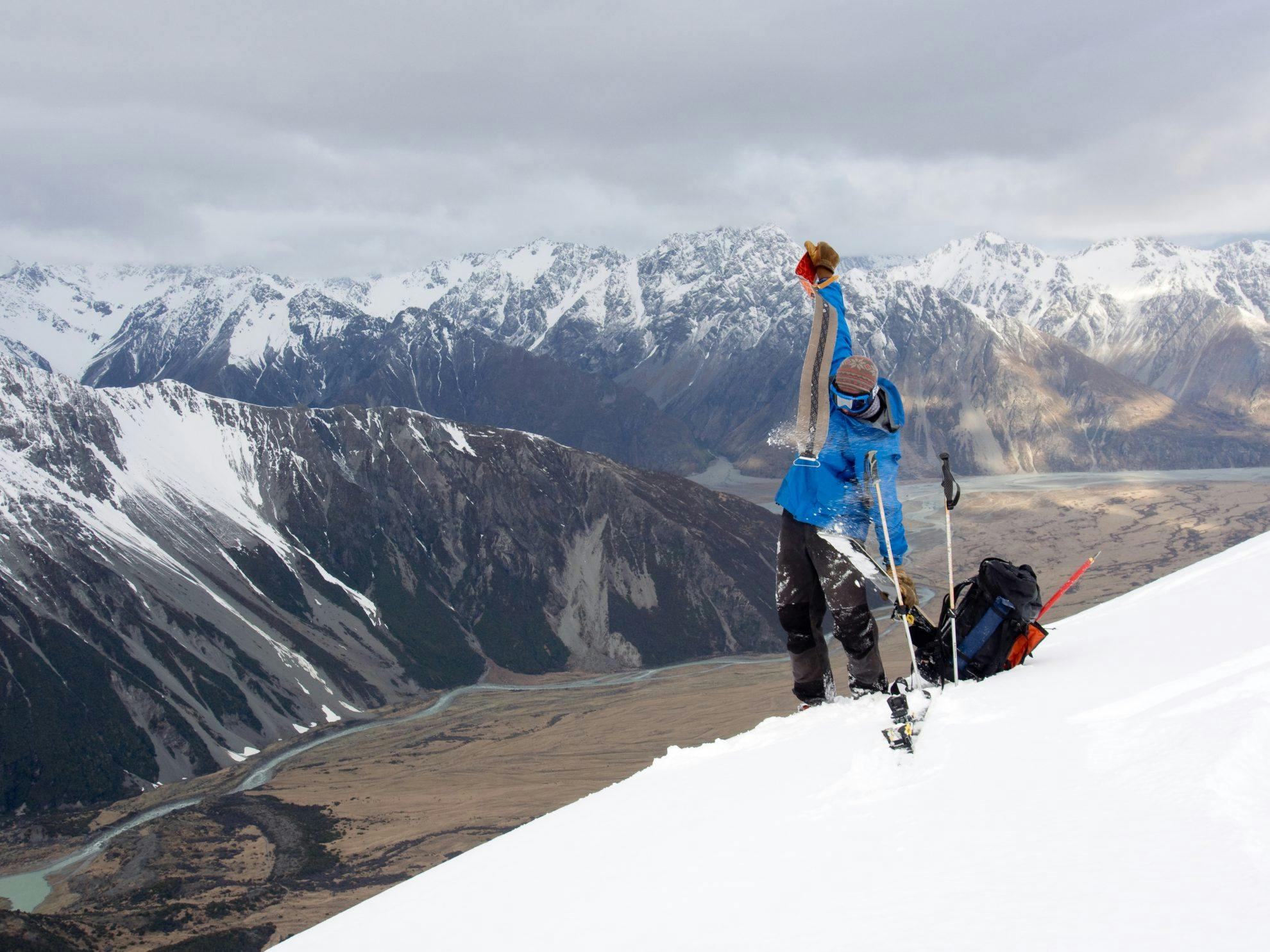
Gear
It has been said that ski touring is a great way to spend a lot of money but do very little skiing, as you spend most of the time going uphill rather than down. While there is some truth to this, don’t be deterred – it’s never been easier to get good quality gear (new and secondhand) at a reasonable price. You can even rent the gear you need from an outdoor shop to see if you enjoy touring before investing in all the kit.
Boots
Nothing ruins a nice day touring like uncomfortable ski boots. If there’s one piece of gear worth investing in, it’s your boots, so don’t be afraid to spend a bit more to get boots that fit perfectly. Ski touring boots are similar to normal ski boots, but they are lighter and have a ‘walk mode’ which makes them more comfortable when you are skinning and walking.
Bindings
Touring bindings are loosely broken into two types: ‘frame’ and ‘technical’. Frame bindings look like normal ski bindings but are more bulky. They fit a wide range of boots and are easy to take on and off. Technical bindings are smaller, lighter and smoother to use, making them popular among experienced skiers who want to reduce weight.
Skis and skins
You can use any off-piste ski for touring, but it’s worth getting skis which can handle a range of conditions and are not too heavy. A ski width of 100mm underfoot should be plenty for New Zealand conditions. Avoid skis taller than you if you don’t want to fall on your bum when performing a kick-turn on the uphill. Specialised touring skis are great for getting up the hill, but they can be more susceptible to damage due to their lightweight design.
Skins are the easiest piece of gear to buy, but can be the hardest to maintain. Clean and dry them after every use, and store them in a cool, dry place.
Clothes
Skiing up a mountain is just like walking up one: it’s hot and hard work, especially if the sun is beating down. Focus on wearing fabrics that breathe but also keep you warm. A merino base-layer will wick sweat, a fleece mid-layer will keep you warm and a soft or hard-shell jacket and pants will keep out the wind and snow. An insulated jacket is also worth keeping in your pack in the event the weather gets nasty or your day trip turns into an unplanned overnighter. Always pack a sun hat and sunglasses.
Snow safety gear
As a minimum, you should be carrying an avalanche transceiver, snow shovel and probe and have the skills and knowledge to use them. You can’t buy bad snow safety equipment if you stick to the major brands, but be wary of secondhand transceivers older than 10 years as their technology is outdated. Practise your transceiver searches in a park to polish those search skills.
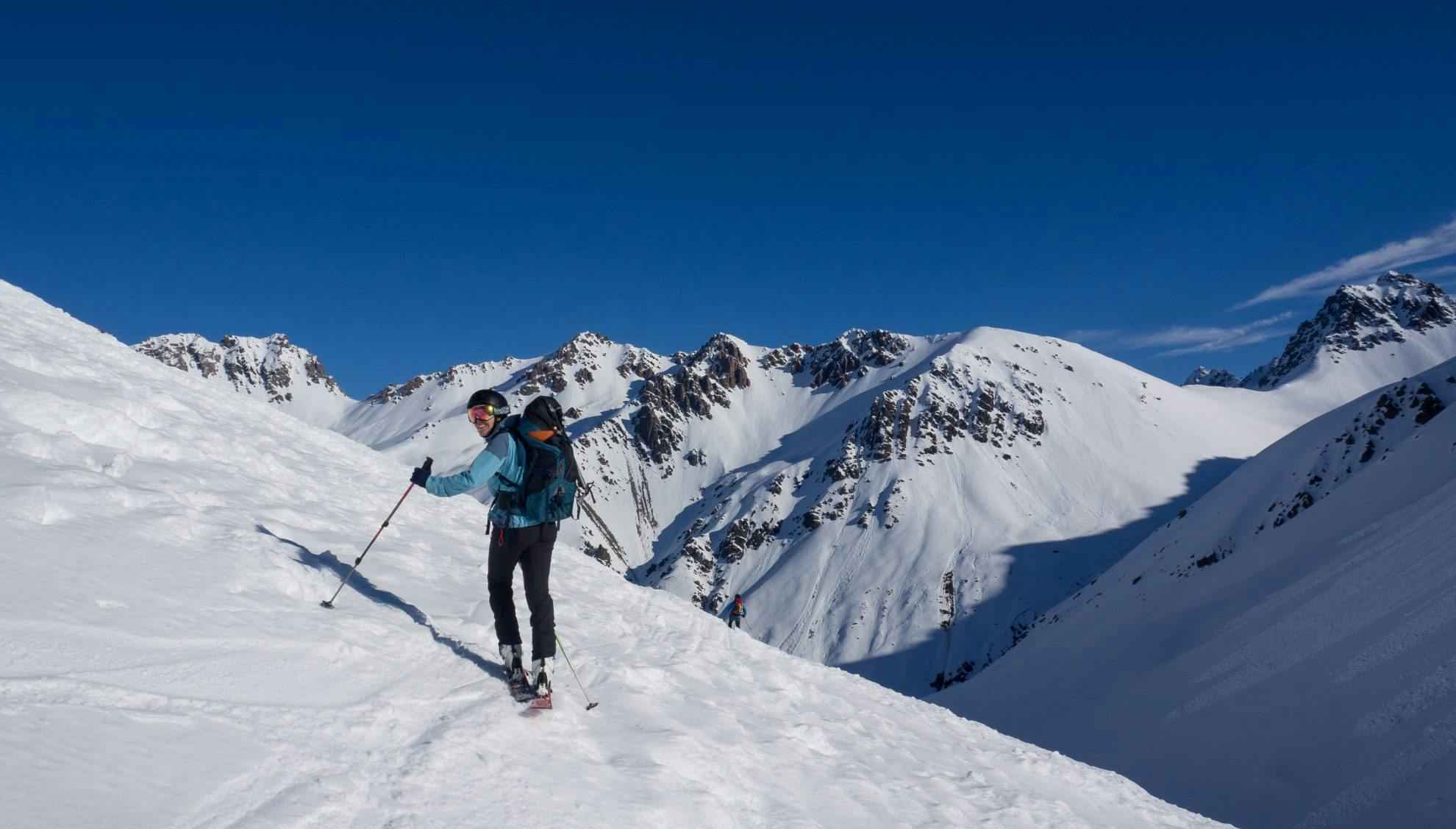
I’ve done it!
Anna Pearson began ski touring a couple of years ago and hasn’t looked back.
Anna Pearson has been a skier all her life and begun ski touring after seeing some friends ski down a basin behind Temple Basin Ski Area and then skin back up.
It looked like fun, so she invested in a pair of alpine touring boots.
Her first trip was into Tarn Basin beside Mt Cheeseman Ski Area on a pair of touring skis she bought from a ski sale for $150.
After enjoying the experience, she went on to buy some new, lighter skis and Marker F12 bindings – a set-up she could use for both touring and downhill skiing around the Canterbury club fields.
“It’s great for someone who just dabbles in ski touring,” Pearson says. “The bindings are a bit heavier than other options, but they’re super easy to use and when they’re clicked in they feel just like a normal downhill binding.”
Pearson tramps regularly and says she is going to the gym to improve her fitness. “Ski touring has definitely started to cure my aversion to cardio,” she says. “My second time on skins was during a three-day trip in the Cass Valley last year, where we stayed in a hut and ventured out for day trips. It was an amazing experience, but I also found it extremely tiring and struggled to keep up, which has motivated me to improve my fitness.”
Pearson says the most surprising thing about ski touring was discovering how much she enjoyed it. “It’s like tramping up a mountain but at the end you get to ski down, which is a whole lot more fun. I was also surprised at how hard it was to change direction while skinning up a steep slope. It can be really frustrating until you get the knack.”
She’s relied on her more experienced friends to plan trips and for on-mountain safety, but would like to learn more about avalanche awareness and how to pick the best terrain for safe and efficient travel.





